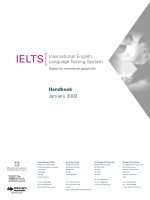Contractions english grammar
Bạn đang xem bản rút gọn của tài liệu. Xem và tải ngay bản đầy đủ của tài liệu tại đây (17.44 KB, 2 trang )
Contractions
The forms like I’ve, don’t etc. are called contractions. There are two kinds:
Auxiliary verb + not
can’t (= cannot)
wouldn’t (= would not)
shouldn’t (= should not)
won’t (= will not)
haven’t (= have not)
isn’t (= is not)
You shouldn’t do it.
I can’t come.
He won’t go.
Noun / pronoun / etc + auxiliary verb
I’m. (= I am.)
She’s gone. (= She has gone.)
They’ve come. (= They have come.)
Where’s the station? (= Where is the station?)
Nobody’s there. (= Nobody is there.)
Contractions are formed with modal auxiliary verbs, and also with be and have when they are not auxiliary verbs.
The contracted form ‘s can be written after nouns, pronouns, questions words, here and now.
She’s ready. (= She is ready.)
Here’s our bus. (= Here is our bus.)
The short forms ‘ll, ‘d and ‘re are written after pronouns and unstressed there.
She’d like to talk to you. (= She would like to talk to you.)
You’re very late. (= You are very late.)
He’ll come. (= He will come.)
In other cases we usually write the full forms.
Alice will be surprised to find you here. (NOT Alice’ll be …)
Contractions are not usually written with double subjects.
John and I have decided to go on a vacation. (NOT John and I’ve decided to go on a vacation.)
Note that in a contraction the apostrophe goes in the same place as the letters that we leave out.
Examples are:
hasn’t = has not (NOT ha’snt)
they’d = they would (NOT the’yd)
Note that shan’t and won’t have only one apostrophe each although words are left out in more than one place.
shall not = shan’t
will not = won’t
Stay on top of your writing! Download our grammar guide from www.englishgrammar.org to stay up-to-date.
Powered by TCPDF (www.tcpdf.org)









